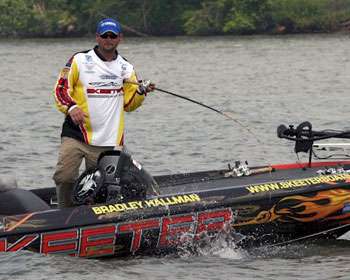
When the Bassmaster Elite Series visited Oklahoma's Grand Lake in 2007, Oklahoma pro Bradley Hallman wasn't surprised to see nearly half the field flipping shallow willow trees on the first morning of competition. A willow wizard himself, Hallman knows that when the bass are in the willows, big limits will be weighed in.
For Hallman, all willows are not created equal. "When you are fishing willow trees, the main thing to remember is that there is generally a pattern inside the pattern," he explains. "I've seen guys just go out and start fishing a row of willows that's a mile long and wonder why they didn't catch bass. Generally, there's a rhyme and reason those fish are on certain willows and not on others."
The No. 1 thing Hallman pays attention to when he is searching for productive willows is water depth. Prior to launching his boat, he will look at the lake level and determine if the water is rising or falling.
When facing low water conditions, the Oklahoma pro targets deeper, dead willow trees that are located in front of green willows in shallow water. "The dead willows die because they always have too much water covering them," says Hallman. "After they die, all that's left is a stump, and that can be a really good pattern."
Under high water conditions, Hallman takes any means necessary to put his black-neon tube in the thickest and gnarliest patch of willows he can reach. "I'll just keep dropping my bait in the thickest stuff I can find, even if I have to go to a 1-ounce weight," he says. "Especially if the water is a little bit deeper, that heavy bait flying by the bass will trigger a strike."
Regardless of the water level, Hallman is always searching for willows that stand out from the crowd. "To me, the best willows look obvious, but I think a lot of people just drive by them," he allows. He often focuses on trees located on shallow points and ones that are "out away from anything else." Hallman believes that these isolated willows often hold bass because many anglers don't think it's worth the time to fish such a small target.
"One of the best days I've ever had flipping willow trees was when nobody else was flipping them because they didn't think there was enough water in them," he says. "I was targeting isolated willows that were located in the very backs of pockets in a little deeper water. There was a big bass on every single one of them."
When targeting willows, Hallman also looks for what he calls "bass condos" — places offering the perfect combination of depth, location and cover that almost always hold quality fish. According to Hallman, bass condos are created by "the horizontal limb growing off of the willow that is lying in the water." The horizontal limb not only creates more cover but it also serves as a canopy, shading the base of the willow tree. "That's the juice," claims Hallman. "When I come to that condo, the Power Pole goes down and I dissect the willow into little squares and start flipping. Sometimes it might be on my 15th flip before I get a bite, but I know they're in there."
Hallman also points out that under the right conditions, productive willows will quickly be replenished with bass. "The same willows will never to be as strong as the first day you catch bass off of them, but if you're on a good willow lake and find the pattern within the pattern, you should be able to find more bass," he says.
Hallman offers this final piece of advice when it comes to flipping willows: "Knowing where to focus your casts and how many casts to make at each tree will definitely make a difference in the number and quality of fish you catch."




